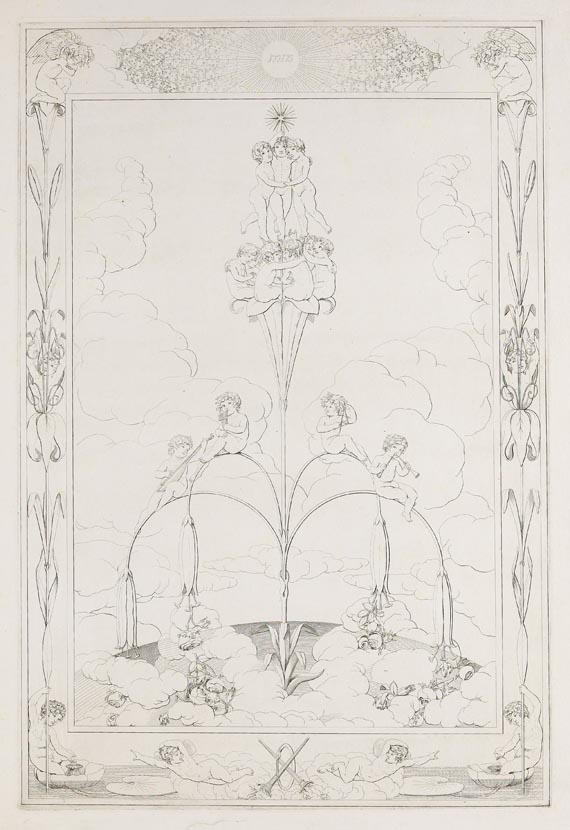Dictionary


Early Romanticism
Philipp Otto Runge (1777-1810) and Caspar David Friedrich (1774-1840) were the two leading artists of German Early Romanticism. Both were associated with the circle of the Dresden early romanticists, where they met for scholarly discussions with, among others, Schlegel, Schelling and Novalis, in the picture gallery before the turn of the century. Apart from the stylistic idea, their common motif is the human figure in a landscape, which arouses emotions in he observer that were intended by the artist.
Runge created landscapes in a coloring that seemed to be almost unreal in terms of the atmosphere created by light and space. In order to convey emotions, he often used personifications and Baroque allegories instead of real people with definable attributes. The cycle "Tageszeiten" (Times of the Day) counts among his most famous works, just "Morgen" (Morning) was executed in two versions in 1808-09, which brings up the topic of the position of the human in cosmos and the forces of divine creation in an allegorical manner.
Caspar David Friedrich depicts real places in his works, which he symbolically romanticizes, staging them as, for instance, conveyors of Christian ideas ("Abtei im Eichwald", 1809-10). He often integrates the rear-view figure, a stylistic device that is typical for his works, that seems to be gazing in the infinite distance, thus enabling the observer to immerse into the picture and to feel the power of nature. His paintings "Wanderer über dem Nebelmeer" (Wanderer at the Foggy Sea), made around 1817 or the "Mönch am Meer" (Monk at the Sea), made 1808-1810, adhere to this particular style. Even though Friedrich's works did not have a clear impact on the formation of the school of painting itself, they did, however, influence a number of artists, among them Carl Gustav Carus, Johan Christian Dahl and Ernst Ferdinand Oehme. Friedrich also served as a model for Carl Blechen, whose landscape paintings already hint at Realism.
Philipp Otto Runge (1777-1810) and Caspar David Friedrich (1774-1840) were the two leading artists of German Early Romanticism. Both were associated with the circle of the Dresden early romanticists, where they met for scholarly discussions with, among others, Schlegel, Schelling and Novalis, in the picture gallery before the turn of the century. Apart from the stylistic idea, their common motif is the human figure in a landscape, which arouses emotions in he observer that were intended by the artist.
Runge created landscapes in a coloring that seemed to be almost unreal in terms of the atmosphere created by light and space. In order to convey emotions, he often used personifications and Baroque allegories instead of real people with definable attributes. The cycle "Tageszeiten" (Times of the Day) counts among his most famous works, just "Morgen" (Morning) was executed in two versions in 1808-09, which brings up the topic of the position of the human in cosmos and the forces of divine creation in an allegorical manner.
Caspar David Friedrich depicts real places in his works, which he symbolically romanticizes, staging them as, for instance, conveyors of Christian ideas ("Abtei im Eichwald", 1809-10). He often integrates the rear-view figure, a stylistic device that is typical for his works, that seems to be gazing in the infinite distance, thus enabling the observer to immerse into the picture and to feel the power of nature. His paintings "Wanderer über dem Nebelmeer" (Wanderer at the Foggy Sea), made around 1817 or the "Mönch am Meer" (Monk at the Sea), made 1808-1810, adhere to this particular style. Even though Friedrich's works did not have a clear impact on the formation of the school of painting itself, they did, however, influence a number of artists, among them Carl Gustav Carus, Johan Christian Dahl and Ernst Ferdinand Oehme. Friedrich also served as a model for Carl Blechen, whose landscape paintings already hint at Realism.
Offers
Headquarters
Joseph-Wild-Str. 18
81829 Munich
Phone: +49 89 55 244-0
Fax: +49 89 55 244-177
info@kettererkunst.de
Louisa von Saucken / Undine Schleifer
Holstenwall 5
20355 Hamburg
Phone: +49 40 37 49 61-0
Fax: +49 40 37 49 61-66
infohamburg@kettererkunst.de
Dr. Simone Wiechers / Nane Schlage
Fasanenstr. 70
10719 Berlin
Phone: +49 30 88 67 53-63
Fax: +49 30 88 67 56-43
infoberlin@kettererkunst.de
Cordula Lichtenberg
Gertrudenstraße 24-28
50667 Cologne
Phone: +49 221 510 908-15
infokoeln@kettererkunst.de
Hessen
Rhineland-Palatinate
Miriam Heß
Phone: +49 62 21 58 80-038
Fax: +49 62 21 58 80-595
infoheidelberg@kettererkunst.de
We will inform you in time.




